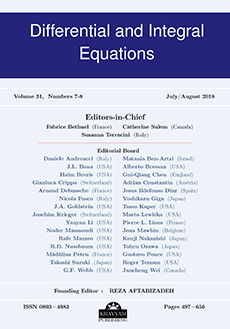Abstract
We study the existence and multiplicity of positive solutions to $n\times n$ systems of the form \begin{align*} -\Delta u_1&=\lambda f_1(u_2)& \mbox{ in }\Omega\\ -\Delta u_2&=\lambda f_2(u_3)&\mbox{ in }\Omega\\ \vdots \quad &= \quad\vdots&\\ -\Delta u_{n-1}&=\lambda f_{n-1}(u_n)&\mbox{ in }\Omega\ \ -\Delta u_n&=\lambda f_n(u_1)&\mbox{ in }\Omega\\ u_1&=u_2=...=u_n=0 &\mbox{ on }\partial\Omega. \end{align*} Here $\Delta$ is the Laplacian operator, $ \lambda$ is a non-negative parameter, $\Omega$ is a bounded domain in $\mathbb R^N$ with smooth boundary $\partial\Omega$ and $f_i\in C^1([0,\infty)),$ $i\in\{1,2,\dots,n\},$ belongs to a class of strictly increasing functions that have a combined sublinear effect at $\infty$. We establish results for positone systems ($f_i(0)\geq0,$ $ i\in\{1,\dots,l-1,l+1,\dots,n\}$ and $f_l(0)>0$ for some $l\in\{1,\dots,n\}$), semipositone systems (no sign conditions on $f_i(0)$) and for systems with $f_i(0)=0,$ $ i\in\{1,2,\dots,n\}.$ We establish our results by the method of sub and supersolutions.
Citation
Jaffar Ali. Ken Brown. R. Shivaji. "Positive solutions for $n\times n$ elliptic systems with combined nonlinear effects." Differential Integral Equations 24 (3/4) 307 - 324, March/April 2011. https://doi.org/10.57262/die/1356019034
Information





